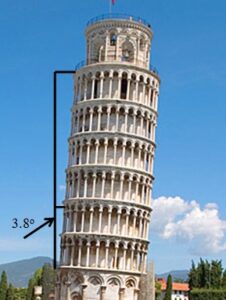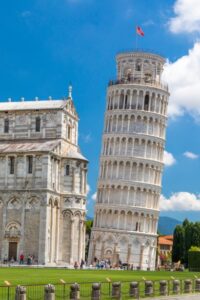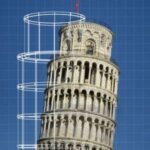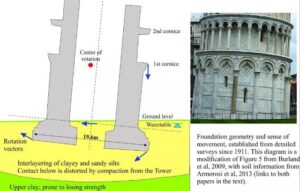
 Many people think that the Leaning Tower of Pisa was once straight, and then gradually began to lean, but that is not the case at all. Nevertheless, the lean became problematic over time. Construction on the Leaning Tower began on August 9, 1173. The plan was for the tower to house the bells of the vast cathedral of the Piazza dei Miracoli, which means the “Place of Miracles” in English. The city of Pisa at that time was a major trading power and one of the richest cities in the world. The bell tower was designed to be the most magnificent tower Europe had ever seen. Work progressed…until the tower was just over three stories tall, and then it abruptly stopped for reasons unknown. There has been speculation as to why the construction was stopped. Some people think it may have been because of economic or political strife, but the consensus seems to be that the engineers may have noticed that even then, the tower had begun to sink down into the ground on one side.
Many people think that the Leaning Tower of Pisa was once straight, and then gradually began to lean, but that is not the case at all. Nevertheless, the lean became problematic over time. Construction on the Leaning Tower began on August 9, 1173. The plan was for the tower to house the bells of the vast cathedral of the Piazza dei Miracoli, which means the “Place of Miracles” in English. The city of Pisa at that time was a major trading power and one of the richest cities in the world. The bell tower was designed to be the most magnificent tower Europe had ever seen. Work progressed…until the tower was just over three stories tall, and then it abruptly stopped for reasons unknown. There has been speculation as to why the construction was stopped. Some people think it may have been because of economic or political strife, but the consensus seems to be that the engineers may have noticed that even then, the tower had begun to sink down into the ground on one side.
The tower sat unfinished for 95 years, which allowed the building to settle, and the new chief engineer tried to figure out a way to compensate for the tower’s visible lean by making the new stories slightly taller on the short side. In theory, that may have seemed like a viable solution, but when you add weight without addressing the problem that is causing the building to sink, you are fighting against yourself. By 1278, when the workers had reached the top of the seventh story, they were forced to stop construction again, because they realized that the southward tilt was now nearly three feet…even with the adjustments they had tried to make to compensate.
The frustrated Italian government, rather at its wits end, announced on February 27, 1964, that it would be accepting suggestions on how to save the renowned Leaning Tower of Pisa from collapse. By this time, the top of the 180-foot tower was hanging an astonishing 17 feet south of the base, and to make matters worse, studies showed that the tilt was increasing by a fraction every year. That may not seem like so much, but like the “straw that broke the camel’s back,” no one knew Exactly when the point would come when the tower could not be saved. That also meant that the tower was unsafe to allow people to come in, or at least it was perceived to be eminently unsafe, and when the experts warned that the medieval building…one of Italy’s top tourist attractions, was in serious danger of collapse in an earthquake or storm, something had to be done.
The Italian government began to reach out in earnest for proposals to save the Leaning Tower, and proposals came from all over the world, but it was not until 1999 that successful restorative work began. In recent years, the cause of the lean was finally determined to be that the tower’s lean was caused by the remains of an ancient river estuary located under the building. That information told them that a completely safe resolution was unlikely, and that straightening the tower was completely out of reach in its current location.
In 1990, the Italian government closed the Leaning Tower’s doors to the public out of safety concerns and began considering more drastic proposals to save the tower. Then, in 1992, in an effort to temporarily stabilize the building, plastic-coated steel tendons were built around the tower up to the second story. In 1993, a concrete foundation was built around the tower, adding counterweights on the north side. The use of these weights lessened the tilt by nearly an inch, bringing new hope to the people. Still, it was an eyesore, and in 1995, the commission overseeing the restoration sought to replace the unsightly counterweights with underground cables. The strange method to do this was that engineers froze the ground with liquid nitrogen in preparation for the removal of the counterweights. Unfortunately, this actually caused a dramatic increase in the lean and the project was called off. Finally, in 1999, engineers began a process of soil extraction under the north side that within a few months was showing positive effects. The soil was removed at a very slow pace, no more than a gallon or two a day, and a massive cable harness held the tower to avoid any sudden destabilization. Finally, it seemed that progress was being made. Within six months, the tilt had been reduced 
 by over an inch, and by the end of 2000, nearly a foot. Relieved, the Italian government was able to reopen the tower to the public in December 2001, after a foot-and-a-half reduction had been achieved. While this will not stop the continuing tilt, it is expected that those 18 inches will give another 300 years of life to the Leaning Tower of Pisa…an amazing feat indeed. The tower will have to be carefully monitored to ensure the safety of those who visit it every year, but for now, disaster has been averted.
by over an inch, and by the end of 2000, nearly a foot. Relieved, the Italian government was able to reopen the tower to the public in December 2001, after a foot-and-a-half reduction had been achieved. While this will not stop the continuing tilt, it is expected that those 18 inches will give another 300 years of life to the Leaning Tower of Pisa…an amazing feat indeed. The tower will have to be carefully monitored to ensure the safety of those who visit it every year, but for now, disaster has been averted.


Leave a Reply